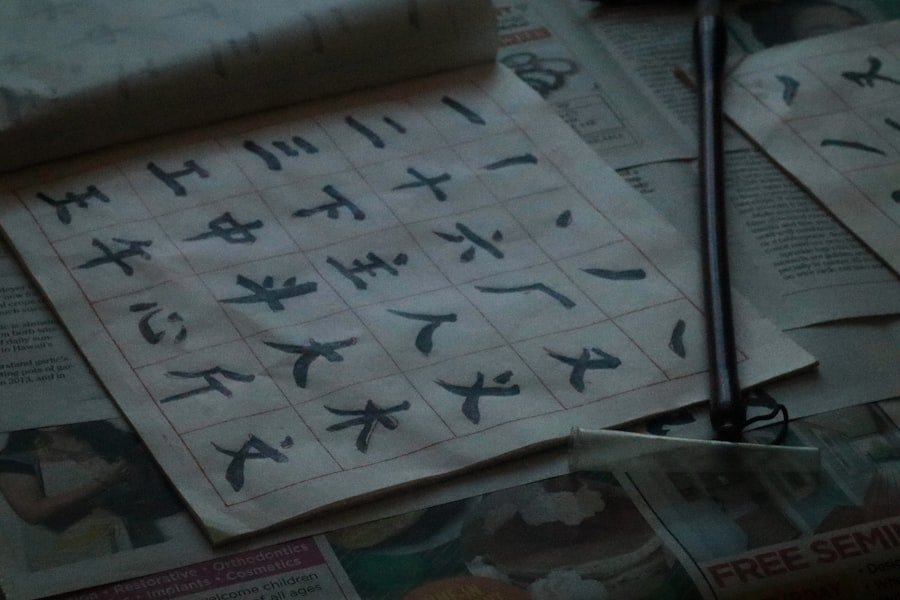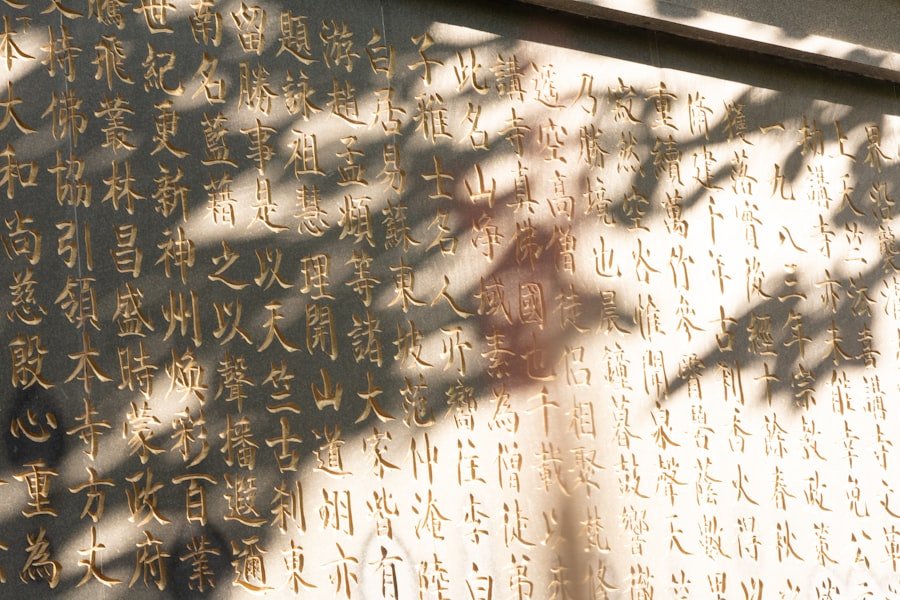Learning multiple Chinese scripts offers a wealth of benefits that extend beyond mere language acquisition. The two primary scripts, Simplified and Traditional Chinese, each possess unique characteristics that can enrich a learner’s understanding of the language and its cultural context. By engaging with both scripts, students can develop a more nuanced appreciation for the intricacies of Chinese writing, which is deeply intertwined with the history and philosophy of the language.
This dual approach not only enhances linguistic skills but also fosters a broader cultural awareness, allowing learners to connect with a diverse range of texts, from classical literature to contemporary media. Moreover, mastering both scripts can significantly improve cognitive flexibility. The process of switching between Simplified and Traditional characters requires learners to adapt their thinking and problem-solving strategies, which can lead to enhanced mental agility.
This cognitive exercise is particularly beneficial in an increasingly globalised world where cross-cultural communication is paramount. By learning multiple scripts, students are better equipped to navigate various contexts, whether they are engaging in business negotiations or participating in cultural exchanges. Ultimately, the ability to read and write in both Simplified and Traditional Chinese opens doors to a richer understanding of the language and its speakers. Master the art of Chinese calligraphy. Enroll now at the LC Chinese School in Oslo.
Table of Contents
ToggleSummary
- Learning multiple Chinese scripts can improve language proficiency and open up more opportunities for communication and understanding.
- Traditional Chinese characters can enhance language proficiency by providing a deeper understanding of the language’s history and cultural context.
- Exploring the differences between simplified and traditional Chinese characters can provide insight into the evolution of the language and its regional variations.
- Learning both simplified and traditional Chinese characters can have a significant impact on language skills, allowing for greater flexibility and adaptability in different contexts.
- Mastering traditional Chinese characters can deepen cultural understanding and appreciation for the rich heritage and traditions of Chinese-speaking communities.
How Learning Traditional Chinese Characters Can Enhance Language Proficiency
Traditional Chinese characters are often regarded as the more complex form of the language, and this complexity can serve as a powerful tool for enhancing overall language proficiency. The intricate nature of Traditional characters encourages learners to delve deeper into the structure and etymology of words, fostering a greater understanding of their meanings and uses. This exploration not only aids in vocabulary acquisition but also helps learners grasp the subtleties of expression that are often lost in Simplified characters.
As students engage with Traditional characters, they develop a more profound connection to the language, which can lead to improved fluency and confidence in both spoken and written communication. Furthermore, learning Traditional Chinese characters can provide insights into the cultural heritage of Chinese-speaking communities. Many Traditional characters have historical significance and are tied to ancient philosophies, literature, and art forms.
By studying these characters, learners gain access to a wealth of cultural knowledge that enriches their language experience. This cultural immersion can enhance conversational skills, as students become more adept at discussing topics related to history, literature, and social customs. In this way, mastering Traditional characters not only bolsters language proficiency but also cultivates a deeper appreciation for the rich tapestry of Chinese culture.
Exploring the Differences Between Simplified and Traditional Chinese Characters

The distinction between Simplified and Traditional Chinese characters is rooted in historical developments that reflect broader social and political changes within China. Simplified characters were introduced in the mid-20th century as part of a government initiative aimed at increasing literacy rates among the population. This simplification process involved reducing the number of strokes in many characters, making them easier to learn and write.
In contrast, Traditional characters have remained largely unchanged for centuries, preserving their original forms and complexities. These differences extend beyond mere aesthetics; they also influence how language is taught and learned. For instance, learners who focus solely on Simplified characters may miss out on the rich historical context embedded in Traditional characters.
Additionally, certain words or phrases may have different connotations or usages depending on which script is employed. Understanding these nuances is crucial for effective communication, particularly in formal or literary contexts where Traditional characters are often preferred. By exploring the differences between these two scripts, learners can develop a more comprehensive understanding of the language as a whole.
The Impact of Learning Both Simplified and Traditional Chinese Characters on Language Skills
The ability to read and write in both Simplified and Traditional Chinese characters can have a profound impact on a learner’s overall language skills. This dual proficiency allows individuals to access a wider range of texts, from modern publications to classical literature, thereby enriching their reading experience. For instance, many historical documents, poetry, and philosophical works are written in Traditional characters, while contemporary media often employs Simplified characters.
By mastering both scripts, learners can engage with a diverse array of materials that enhance their comprehension and appreciation of the language. Moreover, being proficient in both scripts can significantly improve communication skills. In today’s globalised world, interactions with Chinese speakers may occur in various contexts where either script is used.
For example, business professionals may encounter Simplified characters in mainland China while engaging with Traditional characters when dealing with Taiwan or Hong Kong. By being adept in both forms, learners can navigate these situations with ease, fostering better relationships and facilitating smoother exchanges. Ultimately, this versatility not only enhances language skills but also prepares learners for real-world interactions in an increasingly interconnected environment.
How Learning Traditional Chinese Characters Can Deepen Cultural Understanding
Learning Traditional Chinese characters is not merely an academic exercise; it is an immersive journey into the heart of Chinese culture. Each character carries with it a story, often reflecting historical events, philosophical concepts, or artistic traditions that have shaped Chinese society over millennia. By studying these characters, learners gain insights into the values and beliefs that underpin Chinese culture, fostering a deeper appreciation for its complexities.
Furthermore, engaging with Traditional characters allows learners to explore various cultural expressions such as poetry, calligraphy, and painting. These art forms often rely on the beauty and intricacy of Traditional characters to convey meaning and emotion. As students learn to write these characters through calligraphy courses—such as those offered at the LC Chinese School in Oslo—they not only develop their writing skills but also connect with the artistic heritage of China.
This holistic approach to learning enriches their cultural understanding and enables them to appreciate the aesthetic dimensions of the language.
The Cognitive Benefits of Mastering Multiple Chinese Scripts

The cognitive benefits associated with mastering multiple Chinese scripts are significant and far-reaching. Engaging with both Simplified and Traditional characters requires learners to employ different cognitive strategies, enhancing their problem-solving abilities and mental flexibility. This dual engagement stimulates various areas of the brain responsible for memory retention, pattern recognition, and critical thinking.
As learners navigate the complexities of each script, they develop stronger analytical skills that can be applied across various disciplines. Additionally, research has shown that bilingualism—particularly in languages with distinct writing systems—can lead to improved executive function skills. These skills include enhanced attention control, task-switching abilities, and working memory capacity.
As learners switch between Simplified and Traditional characters, they train their brains to adapt quickly to new information and contexts. This cognitive exercise not only benefits language learning but also translates into improved performance in other academic areas and everyday tasks.
Practical Applications of Knowing Both Simplified and Traditional Chinese Characters
The practical applications of knowing both Simplified and Traditional Chinese characters are vast and varied. In an increasingly interconnected world, proficiency in both scripts can open doors to numerous career opportunities across different sectors such as business, education, translation, and cultural exchange programmes. For instance, professionals working in international trade may find themselves dealing with partners from mainland China who use Simplified characters while also engaging with clients from Taiwan or Hong Kong who prefer Traditional characters.
Moreover, knowing both scripts enhances travel experiences within Chinese-speaking regions. Tourists who can read signs or menus in both forms are better equipped to navigate their surroundings and engage with locals on a deeper level. This ability not only enriches personal experiences but also fosters meaningful connections with native speakers.
Additionally, students pursuing academic studies related to China will benefit from access to a broader range of resources—many scholarly works are published in Traditional characters—allowing for more comprehensive research opportunities.
Overcoming Challenges and Pitfalls When Learning Multiple Chinese Scripts
While the benefits of learning multiple Chinese scripts are clear, learners may encounter various challenges along the way. One common pitfall is confusion between the two scripts; students may struggle to remember which characters belong to which form or mix them up during writing exercises. To overcome this challenge, it is essential for learners to establish a structured study routine that includes regular practice with both scripts separately before integrating them into their learning process.
Another challenge lies in the sheer volume of characters that must be memorised. Both Simplified and Traditional scripts contain thousands of unique characters, which can be overwhelming for beginners. To mitigate this issue, learners should focus on mastering frequently used characters first before gradually expanding their vocabulary.
Employing mnemonic devices or visual aids can also facilitate memorisation by creating associations that make recalling characters easier.
The Role of Stroke Order in Learning Traditional Chinese Characters
Stroke order plays a crucial role in mastering Traditional Chinese characters effectively. Each character is composed of strokes that must be written in a specific sequence to ensure proper formation and legibility. Understanding stroke order not only aids in writing but also enhances reading comprehension; recognising how characters are constructed helps learners decipher unfamiliar words more easily.
Moreover, adhering to correct stroke order fosters good handwriting habits that are essential for clear communication. In calligraphy courses offered at institutions like the LC Chinese School in Oslo, students learn the importance of stroke order as they practice writing Traditional characters beautifully and accurately. This focus on technique not only improves writing skills but also instills a sense of discipline and appreciation for the art form itself.
How Learning Multiple Chinese Scripts Can Improve Reading and Writing Skills
The process of learning multiple Chinese scripts significantly enhances reading and writing skills by providing learners with diverse linguistic tools at their disposal. As students engage with both Simplified and Traditional characters, they develop a more comprehensive understanding of character formation and usage patterns across different contexts. This exposure allows them to become more adept readers who can navigate various texts with greater ease.
In terms of writing skills, familiarity with both scripts encourages learners to experiment with different styles and formats. For instance, those who have mastered Traditional characters may find themselves better equipped to express nuanced ideas or emotions through writing due to their deeper understanding of character meanings and structures. Additionally, this versatility enables learners to adapt their writing style based on their audience or purpose—whether crafting formal essays or informal messages—ultimately leading to improved communication skills.
Tips for Successfully Learning and Mastering Multiple Chinese Scripts
To successfully learn and master multiple Chinese scripts, it is essential for learners to adopt effective strategies tailored to their individual needs. One key tip is to create a structured study plan that allocates time for focused practice on each script separately before integrating them into joint exercises. Consistency is vital; regular practice will reinforce memory retention and build confidence over time.
Another valuable approach is to immerse oneself in authentic materials that utilise both scripts—such as books, films, or online resources—to enhance comprehension skills while keeping learning engaging. Participating in language exchange programmes or joining classes at institutions like the LC Chinese School in Oslo can provide opportunities for real-life application of skills while fostering connections with fellow learners. Finally, embracing mistakes as part of the learning process is crucial; every error presents an opportunity for growth and improvement.
By maintaining a positive attitude towards challenges encountered along the way—whether related to stroke order or character recognition—learners can cultivate resilience that will serve them well throughout their language journey. In conclusion, learning multiple Chinese scripts offers numerous benefits that extend beyond mere linguistic proficiency; it fosters cultural understanding while enhancing cognitive abilities essential for navigating an increasingly interconnected world. With dedication and effective strategies tailored towards mastering both Simplified and Traditional characters—such as those offered through calligraphy courses at institutions like LC Chinese School in Oslo—learners can embark on an enriching journey that deepens their appreciation for this fascinating language and its rich cultural heritage.
Master the art of Chinese calligraphy. Enroll now at the LC Chinese School in Oslo.







